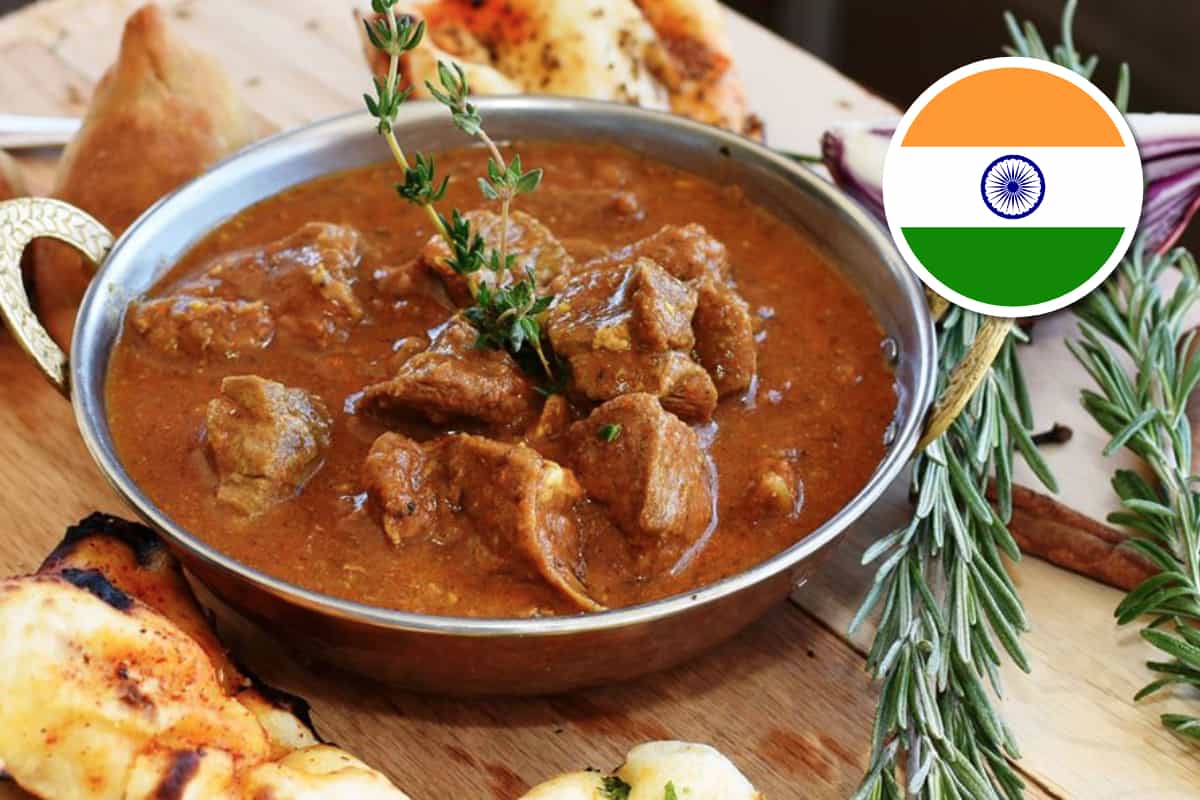The history of Indian food dates back to more than 5000 years. India, as a country, is very diverse. That’s why you will find that each region has its own unique traditions. This has had a direct influence on its cuisine.
Of course, it’s impossible to talk about Indian food without talking about Indian spices considering that the country is the worlds leading exporter of seasonings. The numerous savory dishes and flavors we now get to enjoy all over the world would not be possible without them.
Indian food has been significantly influenced by external cultures. This includes Chinese, Persian, Portuguese, and Mongolian cuisines among others. So, you will find that food from various Indian regions have distinct flavor and aroma.
The History of Indian Food Culture – Origins, Influences and Traditions
There is no doubt that external factors have had a massive culinary impact on Indian Cuisine. One of the major sources of external influences is trade.
European and Arab traders brought many new types of food with them in exchange for the highly coveted Indian spices. These new food varieties definitely influenced the local culinary tradition.
For instance, traders coming from Portugal came with new imports such as chilies, potatoes, and tomatoes. This was something new initially but it quickly became a major part of Indian dishes. On the other hand, the cherished asafetida powder and coffee ingredients were bought by the Arabs.
It should be noted that British control also had its own influence. For instance, they introduced tea and soup. Apart from trade, the colonial and conquest periods also shaped how the natives prepared their meals.
The Mughals who were in India between the 1500s and 1600s blended their culinary delights with what they found here. This resulted in new culinary products with notable characteristics. It led to the use of nuts, butter, cream, and meat in the preparation of certain dishes including biryani, pulao, and samosa among others.
Regional Indian Cuisine Influences
This is one of the most culturally diverse countries in the world and with more than 1.3 billion people. Regional cuisines are majorly influenced by the local settings that affect cultural identities as well as religion.
Those who belong to the Buddhist, Hindu, and Jain faiths are mostly vegetarians. They make up for approximately a third of this country’s population. Muslims, on the other hand, tend to feast on meat edibles.
Apart from that, philosophy and natural treatment alternatives have had a share of determining food preparation techniques.
For instance, Ayurveda teachings that emphasize the importance of having well-balanced wellness between the spirit, mind, and the body, has been essential in dictating the best ingredient pairings. However, the use of Ayurveda teachings is still influenced by regional culture and religion.
Muslims don’t eat pork even though they love meat. Meanwhile, Hindus don’t eat beef because they worship cows.
Eastern Indian Cuisine
This region is very popular for its tasty and unique desserts. As a matter of fact, the desserts are normally used in the most popular restaurants in India. They are sweet and leave a delicious lasting taste.
Generally, most dishes from the eastern region are made with mustard oil, poppy seeds, and mustard seeds. So, you will find that they have a light pungent smell. This region usually makes less spicy dishes compared to the others. The most popular food varieties from the Eastern region include:
Kheer
It is also known as payasam. Kheer is a type of Indian dessert that has been around for centuries. During ancient times, it was offered to the gods and that’s why its use is common in Hindi temples.
The creamy rice pudding is made by boiling wheat and rice with sugar and milk. Its flavor can be enhanced by using saffron, nuts, or fruits. Currently, it’s a popular pudding in wedding festivals.
Khaja
It’s a type of traditional Indian dessert that’s popular among the Easterners. Khaja is normally made by using ghee-based dough in addition to flour and sugar. It’s blended and then deep-fried in hot oil until it turns brown.
Even though Khaja has its origins in the Eastern sides, there are still other regional varieties. However, it’s very easy to tell them apart. For instance, Khajas from Rajgir and Silao are usually very puffy. It’s worth noting that sometimes the Khajas may be soaked in sugar syrup to enhance their taste.
Rasgulla
It’s a type of traditional sweet that is served as a dessert. Rasgulla is normally prepared by mixing and cooking semolina dough and chhena paneer in a sugary syrup. The ball-shaped dumplings have to be cooked until the syrup can permeate them.
The white-colored, soft, and fluffy balls melt in the mouth in minutes. They are most commonly used in festivals. This is because they contain too much sugar and most people prefer to eat them as cheat meals.
Note: there has been some debate regarding the origins of this dessert. There are those who claim that its birthplace is Odisha while others think it originated from West Bengal.
Pantua
It has its origin in Bengal. Pantua is a soft, fluffy, and spherical dessert. It’s highly drenched in sugar syrup that’s saffron and cardamom flavored. To make the balls, you need Chhana, flour, baking powder, and khoa- a type of solid dried evaporated milk.
Its taste can be enhanced with the addition of raisins or dry nuts. Pantua is highly versatile to prepare and you can use boiled sweet potatoes as well. It is a common celebratory food that’s used in festivals like Durga Puja.
Note: there are several versions of pantua and what sets them apart is the finish and shape.
Western Indian Cuisine
There are three main regions that have a significant influence on western Indian cuisine: Goa, Gujarat, and Maharashtra. Food from the Goa region is mainly made with beef and pork. Gujarati cuisine has some aspect of Chinese influence and it’s mainly vegetarian. Lastly, Maharashtra is a coastal region, therefore, you are most likely to find coconut milk and fish in most food varieties.
Misal
It’s a type of specialty dish that’s common in Maharashtra. If roughly translated, Misal means a mixture of everything. You can basically use anything to prepare it. That’s why you will find that this dish contains a broad range of ingredients and it varies from one cook to the next.
One thing about Misal is that it’s very spicy and its base needs to be somehow crunchy. The most common combination of ingredients includes garnishing such as tomatoes, onions, and coriander. Besides that, you are most likely to find spiced potatoes, pea curry, curd, moth bean, pav, and gravy.
Misal is generally a colorful edible with lots of colors. You can easily find red, green, and even brown color shades. It’s cheap, easy to prepare, and very nutritious.
Bhakri
Bhakri is not only popular on the western side of India but the whole country. It’s a type of flat unleavened bread with its native origins being Maharashtra. However, you can also find it in other regions such as Goa, Rajasthan, and Gujarat among others.
Bhakri is normally made with wheat flour (sometimes rice flour), ragi, jowar, and sorghum. These are healthy ingredients that are rich in fiber. To enhance its flavor, the flatbread is sometimes made with cumin seeds or ghee butter. The bread tastes better when it’s made with freshly milled flour.
Modak
It’s a type of sweet dumpling with its origins being the western side of India. Cultural studies indicate the Modak originated from Maharashtra. Modak is highly versatile and, therefore, there are multiple ways to prepare it. However, the most common way of preparing it normally involves steamed rice flour that’s filled with grated coconut plus jaggery.
Its consumption is widespread. So, depending on the region, it might have a different name. For instance, those in Telugu normally call it Kudumu, Kadubu, or Modhaka for those in Kannada, and Kozhukattai for those who are in Tamil.
Northern Indian Cuisine
This is the region that has the most prevalent cuisine in India. You can find dishes from the Northern side of India almost anywhere. Generally, you will find that dishes from Northern Indian involve the use of ghee (butter), yogurt, paneer (a type of mild Indian cheese), and milk. Besides that, you will also find foods made with beef, lamb, or chicken meat.
A notable feature that’s associated with the Northern side is its delicious snacks that feature fried delights such as samosas. The most common dishes from Northern India include:
Kadhi
It originated from the Rajasthan part of Northern India. Kadhi is a broad term that references a wide range of various Indian dishes that are made with buttermilk or yogurt. These ingredients are normally used as the base while the edible is made thicker with gram flour.
It’s generally considered a comfort food that can get paired with roti bread or rice. However, there are numerous variations of Kadhi depending on the preparation technique. Punjabi Kadhi is the most common one. It has a thick consistency in addition to the pakora fritters.
Note: the variations are normally distinct because of the additional elements used to alter taste and consistency.
Tandoori Chicken
This is definitely one of the most popular Indian dishes. Tandoori is a name that’s derived from tannur, a Persian word which means fire. Tandoori chicken is made with ingredients such as marinated chicken meat that’s seasoned with cumin, nutmeg, and tandoori masala.
The traditional dish is normally prepared at high temperatures in order to create succulent and tasty meat. To retain its sweet flavor, Tandoori chicken has to be properly baked over a heated oven.
Biryani
Even though this food has its origins in Northern India, Biryani is a world-class food that’s prepared in different parts of the world. History indicates that it was introduced to Indians by the Mughal Empire.
To prepare Biryani, you need basmati rice, meat for the base, vegetables, and spices. The best thing about Biryani is that it’s highly versatile. So, you can use lots of additional ingredients such as eggs, yogurt, nuts, and fruits.
Southern Indian Cuisine
Southern Indian seems to be “isolated” in terms of its culinary delights. That’s why it is not very easy to find dishes from this region in most restaurants. It’s also worth noting that meals from this region are quite unique.
Generally, southern Indian cuisine involves a lot of curries. However, these curries are normally categorized based on their consistencies. The most common ones include the Rasams that resemble soups. There are also sambars that are more watery and made with vegetable stews while kootus are quite creamy. The most common dishes from southern India include:
Masala Dosa
Masala dosa is a tasty dish and one of the most popular dishes from southern India. It is normally made with soaked rice batter in addition to lentils. It’s then baked to make a thin pancake. However, Masala Dosa is highly versatile so you can find it in multiple variations.
For instance, you can find paper masala dosa, onion masala dosa, or Mysore masala dosa. The thin pancake is mostly stuffed with mustard seeds, onions, and potatoes and garnished with chopped coriander and grated coconut.
This is a delicious sweet treat that you can consume while you are on the go. Alternatively, you can incorporate masala dosa to your major meal.
Sambar
It’s a sweet delicacy that originates from the Tamil Nadu region. Sambar found its way throughout the whole of South India due to its Sri Lankan background. Cultural studies indicate that it was made by a mistake.
Sambhaji, the son of the Maratha ruler made this popular curry dish by mistake. He wanted food and because the head chef wasn’t in, he decided to prepare Dal but he then decided to add some tamarind while cooking.
It is a curry that needs to be prepared with a tamarind-based broth in addition to vegetables and lentils. It’s normally served with flatbreads or rice. There are also various variations of sambar including chicken, seafood, and milk sambar.
15 Traditional Indian Foods Popular Around the World
The variety of Indian cuisines is breathtaking. The dishes chosen below can usually be found in Indian restaurants, kitchens and dining tables.
The preparations are not elaborately described, with the main focus being on the specific spices used. Finally, each region in India may add their own distinctive “touch” to the dish, so many variations of these dishes are possible.
1. Aloo Gobi (Cauliflower and Potatoes)
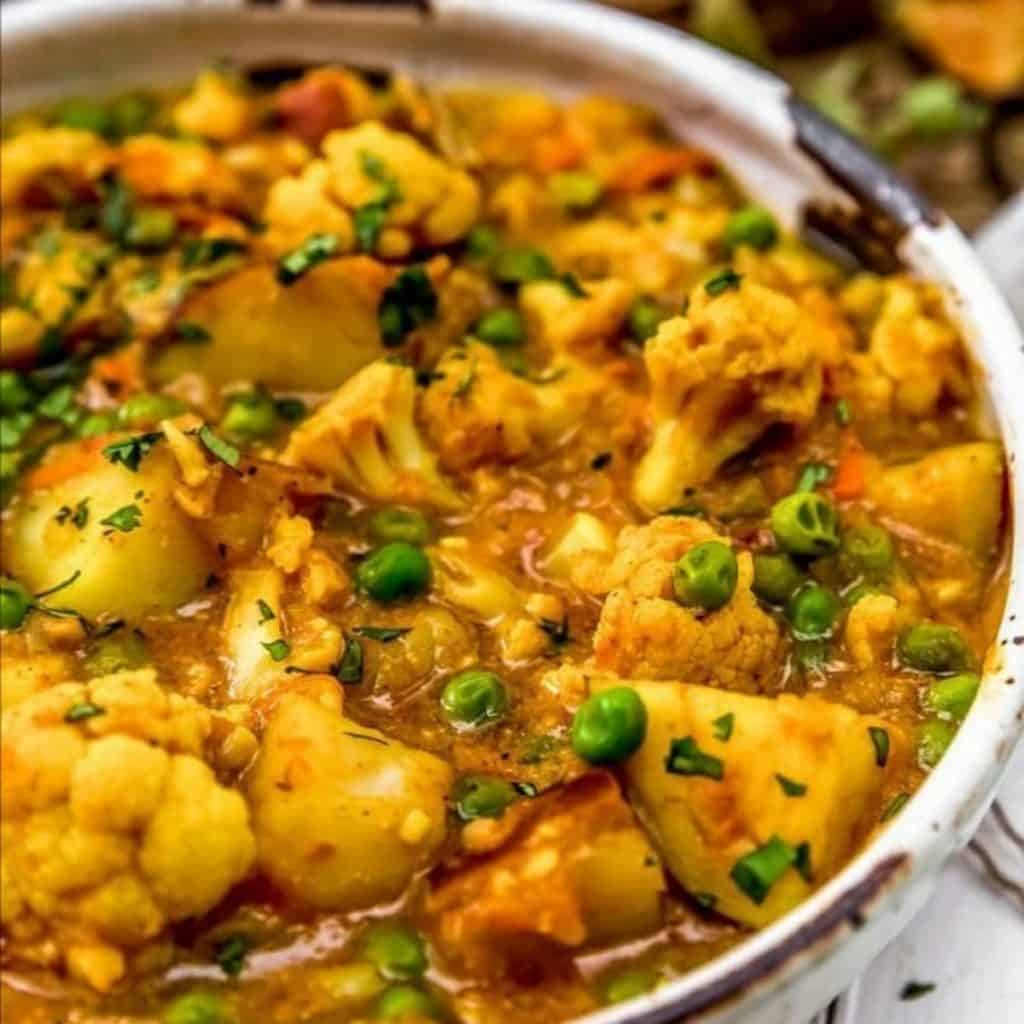
The main ingredients, cauliflower and gobi, are typically prepared separately, since potatoes take longer to soften. Common ingredients are curry leaves, kalonji, onions, tomatoes, garlic, ginger, turmeric, cumin, chilies and coriander stalks. Peas are often added. Here’s a Recipe.
2. Chana Masala (Spicy Chickpeas)
Made with chana or black chana, a lentil twice the size and firmness of, and a stronger flavor than, normal chickpeas, this popular North American dish is made with garlic, onion, ginger, chopped tomatoes, cumin, turmeric, coriander powder, amchoor (mango extract) powder and garam masala and cooked in ghee traditionally.
3. Masoor Daal (Red Lentil Stew)
Masoor dal is made with the common red variety lentils. Easy to prepare, the dish could be made tadka style, where the spices are toasted and fried separately, then added to the boiled lentils. The standard ingredients used include onions, tomatoes, garlic, ginger and chilies (fried until soft) then overlaid with spices such as curry powder, mustard seed, coriander and cumin. Turmeric is added in sometimes. Salt is added to taste.
4. Kaali Daal (Black Lentils)
Black lentils or Urad Dal is cooked with onions, green chilies, tomatoes, ginger and garlic. The distinctive tastes are added by cumin seeds, ground cumin, coriander, red chili powder, salt, ghee and heavy whisked cream, cooked in neutral (vegetable, canola or sunflower oil). A sizable dollop of sour or whipped cream on top will create Daal Makhani.
5. Saag Paneer (Spinach with Cottage Cheese)
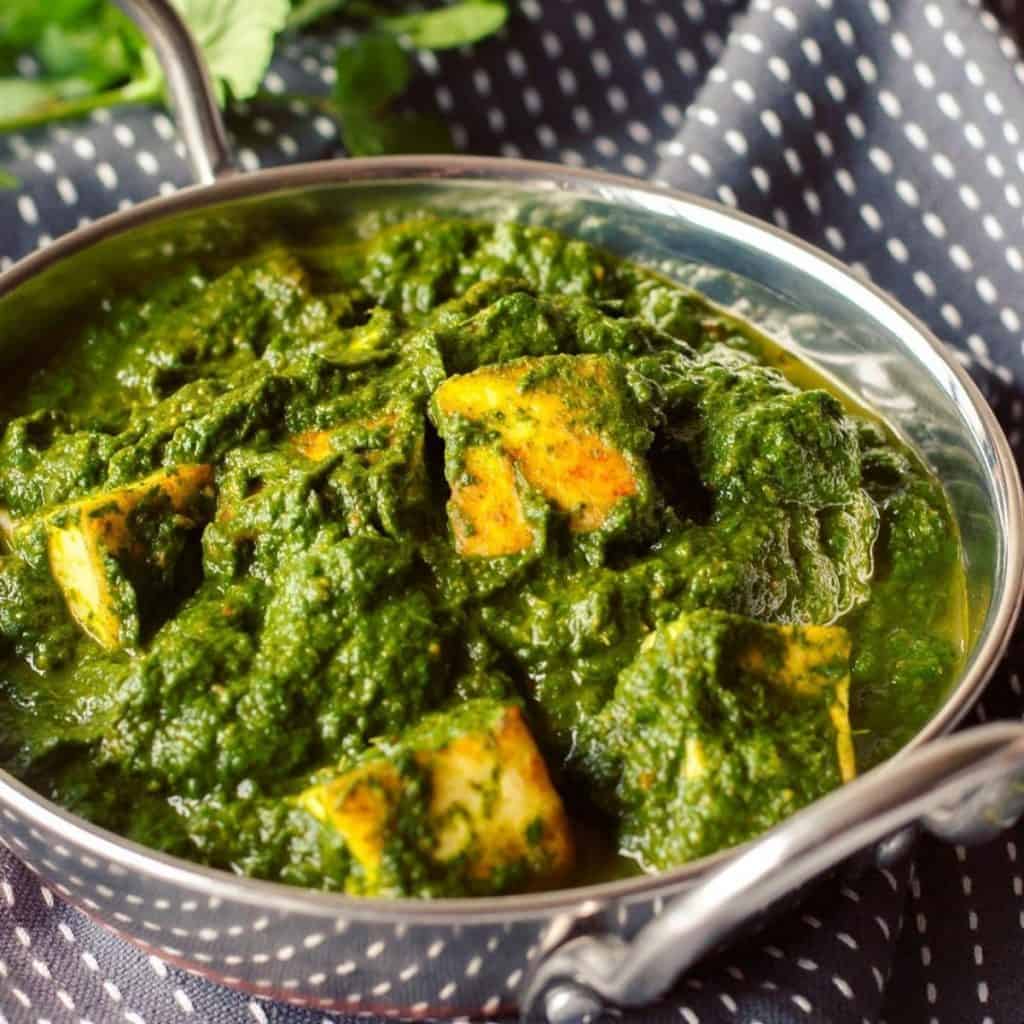
This dish, enormously popular with diners at Indian restaurants, is a spinach curry with a thick cream base with cubes of cottage cheese (paneer) mixed in. The main ingredients are fenugreek leaves, onions, tomatoes, garlic, ginger, turmeric, cumin, coriander and garam masala, fried in canola oil.
6. Sarson ka Saag (Mustard Green Vegetables)
This North West Indian favorite is made with Sarson, combined with ginger and garlic. Ghee or butter may be added to the top. It is typically made with Makki ki Roti (Maize Flour Bread).
7. Shorshe Chingri (Tiger Shrimp with Mustard Sauce)
As the name suggests, this dish is super heavy in mustard flavoring. In fact, both regular and hot mustard powder are typically used, and the dish is cooked in Mustard Oil. Other spices include onions, tomatoes, garlic, ginger, turmeric, green chilies (both chopped and sliced), finely chopped cilantro and red chili powder, plus salt, sugar, yogurt and milk to taste.
8. Lamb Vindaloo (Goan Lamb Curry)
This dish is made by mixing Vindaloo Masala with vinegar and coconut milk to produce vindaloo paste. Boneless lamb pieces are stewed in the paste and cooked over a slow fire. Originally mild and extremely flavorful, the proportion of chilis can be increased to make the dish hot.
9. Chicken Tikka Masala
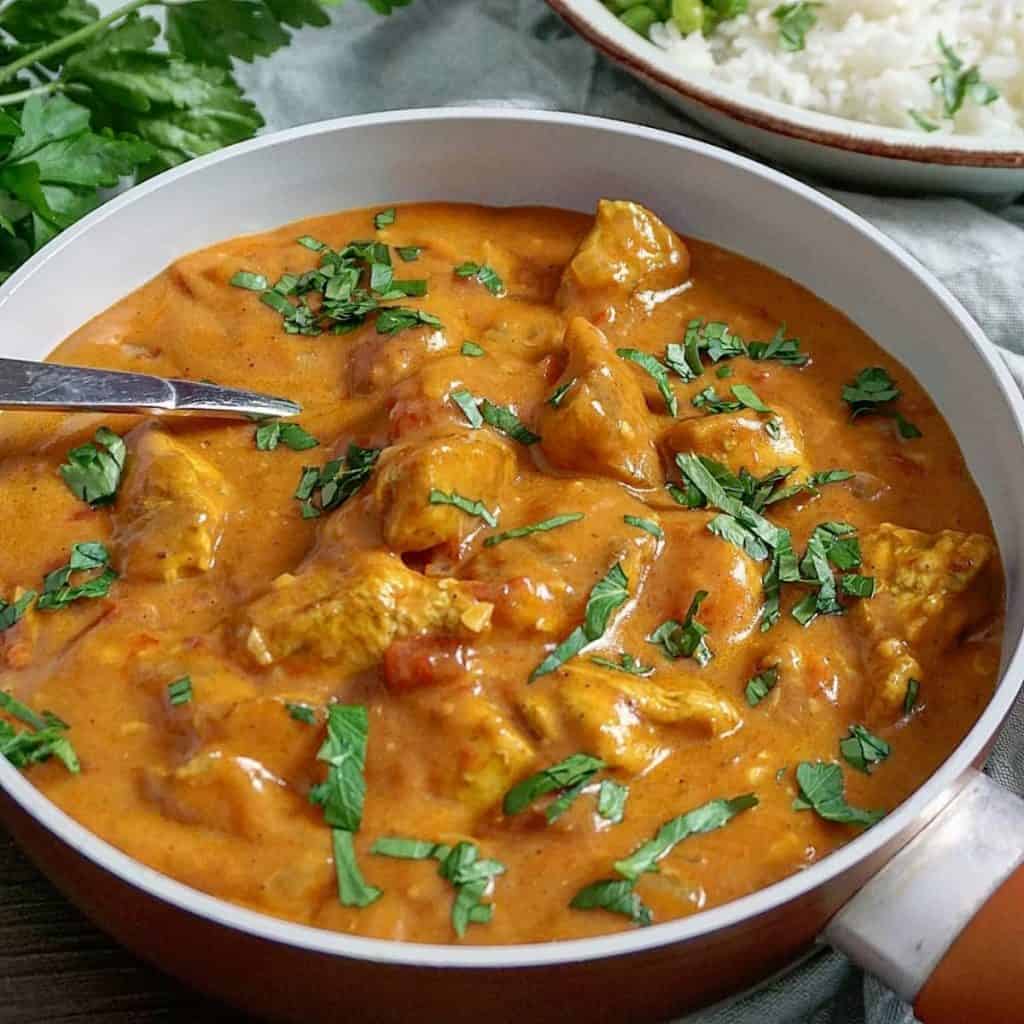
A dish that has become a National Dish in Britain, Chicken Tikka Masala consists of chicken tikka (or boneless chunks of chicken marinated in yogurt and tikka masala), brushed with ghee before being grilled in a tandoori oven. The pieces are doused in a creamy broth made from tomato puree, cream, coconut cream and masala mix, sometimes served with a dollop of butter or cream.
10. Keema Mutter (Ground Meat with Green Peas)
The classic recipe is made with beef, and features onions, tomatoes, garlic, ginger, turmeric, green chili, mild red chili powder, mixed with whole-milk yogurt and cooked in neutral oil such as canola.
21. Tandoori Murgh (Tandoori Chicken)
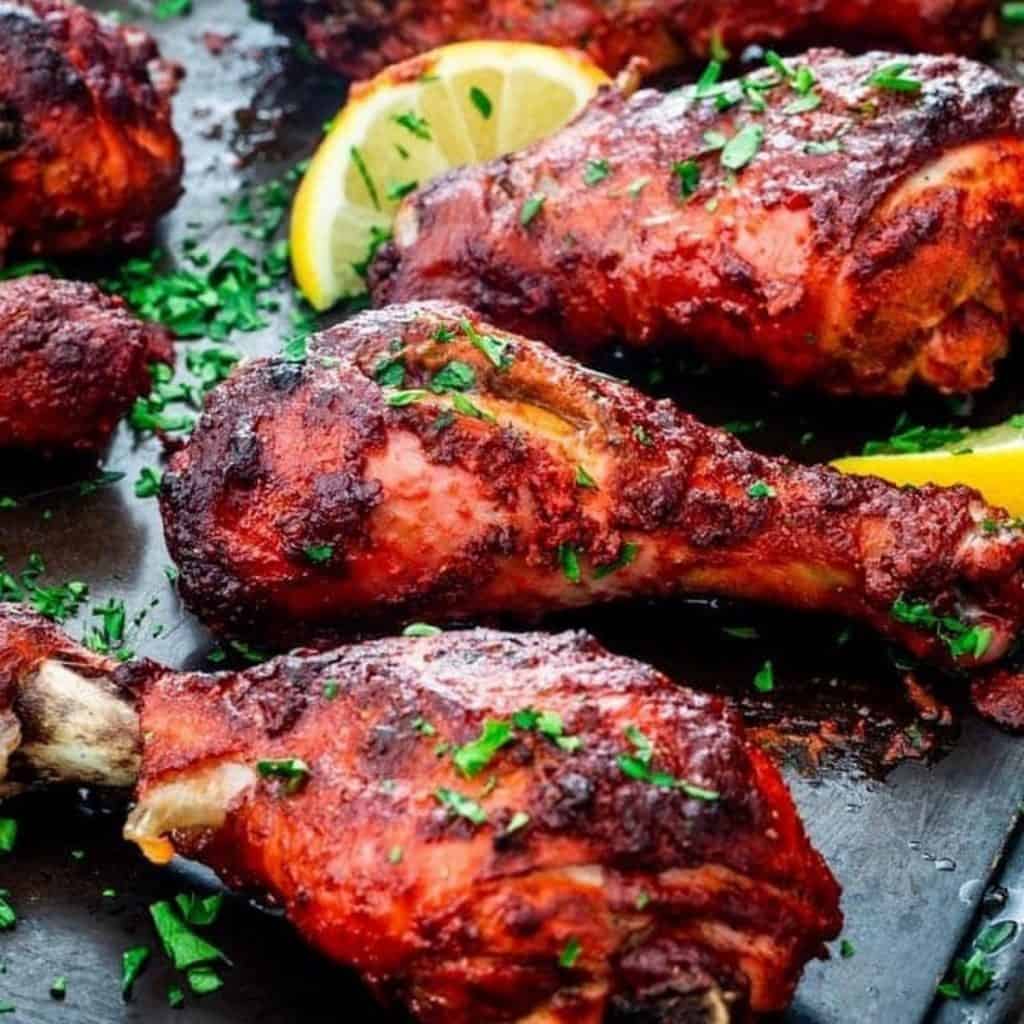
The traditional preparation is to marinate boneless chunks in the tandoori masala and brushing with ghee before grilling inside the clay tandoori oven. Many variations exist. The Kashmiri variety, for example, is grilled on open hot coal pits and does not necessarily use boneless pieces.
11. Hyderabadi Mutton Biryani (Rice Dish with Mutton)
Cooked with basmati rice and goat meat, the ingredients include yogurt, onions, cinnamon, cloves, cardamom, bay leaves, nutmeg, kalonji, mace flower, anise and saffron, with a touch of lemon mixed in.
12. Masala Dosa (Crispy Crepes Stuffed with Potatoes)
The batter for the crepes is made with a proportionate mix of rice, udad dal and chana daal – restaurants may use semolina, flour and other mixes. The rich potato fillings are made with onions, tomatoes, garlic, ginger, turmeric, green chilies, salt and curry leaves for the final flavor. The dish is typically served with sambar dal and coconut chutney.
13. Samosas (Stuffed Vegetable or Meat Stuffed Triangular Savory Pastry)
These deep-fried delights are universally popular starter items. The stuffing is made from boiled potatoes and peas in the classic case, cooked with onions, tomatoes, garlic, ginger, turmeric, green chilies, salt and curry leaves. Cumin and coriander may sometimes be added.
14. Chutneys (Spicy Relish)
Chutneys are the spice of Indian cooking, a condiment that can vary according to the flavoring, ingredients and oil used, the type of vegetable and the amount of chili added for extra heat. Some popular ones include Mango Chutney, Coconut Chutney, Lime Chutney, Tomato Chutney, Yogurt with Green Mint and Mixed Vegetable Chutney.
15. Lassi (Milk Shake)
This dish, used by stirring yogurt with other ingredients such as mango pulps (Mango Lassi), or served with black salt and jeera (namak or Salty Lassi), is a summer delight all over India.
There are variations of many of the dishes outlined above depending on which Indian spices you use. But enjoying them in their original forms is something that will allow you to savor the essences of Iranian cuisine.
25 Quick Facts About Indian Food Culture
- India is the largest consumer, produce, and exporter of spices in the world according to the site ibef.org.
- Chili is widely used: this is considered the most popular spice in India. It’s normally used to add flavor to most meals. India is considered home to some of the hottest chilies in the world.
- Chili, tomato, and potato are the most used base ingredients: they were bought in the country by the Portuguese traders and are the staple food ingredients.
- Most meals are eaten with bare hands: a proper table etiquette requires that you wash your hands before eating.
- Coffee is a common beverage: most people, especially those in urban areas, usually consume coffee daily.
- Booze is important during celebrations: this country has a lively drinking culture that involves traditional millet beers.
- Each region has its unique dishes: all of the four main regions in India normally use unique spices, ingredients, and food preparation techniques to prepare different meals.
- The perfect Indian dish should have 6 flavors: according to the Indian food theory, it is said that an ideal local cuisine should have six different flavors: spicy, sour, salty, bitter, sweet, and astringent.
- Pepper is used to prepare most meals: black pepper was introduced to Indian dishes over 5,000 years ago and the natives still use it to prepare meals.
- Rice and lentils make the staple food: the most popular and the most commonly prepared dishes in India are usually made up of rice and lentil.
- There are numerous unique rice variants: this is the only land in the world with as many rice variants including black, red, white, and brown rice among others.
- Pickles make the traditional meals: this is a vital condiment that is used in nearly all the traditional meals.
- Indians still consume historic staples: until now, Indians are still eating the same types of food they did many centuries back. This mainly includes grains and legumes such as rice, lentils, and wheat flour.
- A typical curry contains at least 6 ingredients: this includes garam masala, tamarind, cinnamon, cardamom, cloves, and cumin.
- Traders had a significant influence on Indian foods: they brought in new food in exchange for chili and other premium spices.
- There are hundreds of Indian desserts: according to Wikipedia, India is a country that has more than 200 types of desserts.
- You can find Indian food anywhere: this is because most of these meals are normally prepared using a combination of natural, local, and exotic spices.
- Naan was originally bought by the Persians: the oven-baked unleavened flatbread was brought into the country by the Persian Mughals.
- Mithais or desserts are important parts of celebrations: every celebration in India is marked with desserts and sweets.
- The Ayurveda system is used to categorize food: there are three main categories of food as per this system: satiric (vegetables), raja-sic (salty, spicy, and oily food), and tamarisk (highly processed and toxic food).
- The country has the 2nd-lowest rate of meat consumption: due to religion, a huge chunk of the population doesn’t consume beef and instead follow a strict vegetarian diet.
- Chicken Tikka Masala isn’t the popular Indian export: a lot of people usually think that this food is originally from India. It was actually invented in Glasgow.
- Food from the south is the least used: this region is quite reserved in terms of culinary delights. So, it’s not common to found southern Indian delicacies in restaurants.
- Northern India has the most vibrant food culture: this region has some of the most popular delicacies and you can easily find them in eateries.
- There is a wide range of delicacies to choose from: this is a country with over a billion people from different regions. So, you can’t miss anything to engage your taste buds.
- There is very little that’s known about the ancient feeding habits of Indians.
Our Verdict…Indian Food Culture Will Keep Growing Everywhere!
The diversity in Indian cuisine is quite interesting. Religion as well as cultural differences have played a crucial role in determining how different regions prepare their favorite dishes.
Besides that, external influence brought about by trade and migration has had its share in influencing the different culinary delights.
But even though these meals are different regionally, the flavor seems to be boundless. You can still find the same dish in a different region with another name. So, this is a country that’s definitely united by its diverse array of culinary delights.
You can see by the popularity of Indian food around the world that the demand is real. People love Indian food and it’s now found everywhere! Combine that with the interesting ways it’s being fused with various cultures and it’s safe to say that Indian food will only keep growing in popularity.

